The Graduate Nursing Project collection includes Doctor of Nursing Practice (DNP) Scholarly Projects and Master's students' non-thesis projects submitted as part of program requirements.
TO
Filters: Collection: ehsl_gradnu
| Title | Creator | Date | Description | ||
|---|---|---|---|---|---|
| 1 |
 |
Maturation 2.0: Menopause Group Education | Moxley, Alyssa | 2023 | POSTER |
| 2 |
 |
Needs Assessment of an In-Patient Unit for Perinatal Mood Disorders at the University of Utah | Tsuhako, Kali Condie | 2023 | Background: The perinatal period represents the time before, during, and after having a baby. This is often assumed to be one of the happiest times of a woman's life. However, for nearly 20% of women, this experience is marked by unanticipated emotional turmoil. Perinatal mood disorders have become ... |
| 3 |
 |
Implementing Risk Assessment Screening Tool for Postpartum Hemorrhage upon Admission to the Postpartum Unit | Bundy, Kelsey L. | 2023 | Background: Postpartum hemorrhage (PPH) continues to remain the leading cause of maternal mortality and morbidity, with increasing numbers in the United States accounting for 11% of pregnancy related deaths (Watkins and Stem, 2020). Obstetric hemorrhage risk assessment screening should be performed ... |
| 4 |
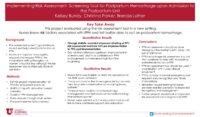 |
Implementing Risk Assessment Screening Tool for Postpartum Hemorrhage upon Admission to the Postpartum Unit | Bundy, Kelsey | 2023 | POSTER |
| 5 |
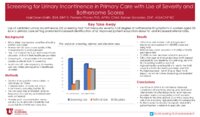 |
Improving the Quality and Frequency of Screening for Urinary Incontinence in the Primary Care Setting | Dean-Smith, Mari | 2023 | POSTER |
| 6 |
 |
Improving the Quality and Frequency of Screening for Urinary Incontinence in the Primary Care Setting | Dean-Smith, Mari | 2023 | Background: Urinary incontinence (UI) is one of the most underreported and underdiagnosed medical conditions affecting women worldwide. Women who suffer from UI have poorer quality of life, and increased anxiety and depression compared to those without UI. One identified reason for women not seeking... |
| 7 |
 |
A Trauma-Informed Care Toolkit: The Utility of the Perinatal Nurse | DiStefano, Kelly A.S. | 2023 | Background: Nurses are central caregivers in the carryout of intrapartum care. Their actions directly impact laboring patients, as well as, other clinical team members. They receive little to no training on trauma-informed care (TIC) despite working with a population more likely to be affect by trau... |
| 8 |
 |
A Trauma-Informed Care Toolkit: The Utility of the Perinatal Nurse | DiStefano, Kelly A.S. | 2023 | POSTER |
| 9 |
 |
Use of Intentional Positioning During Labor to Promote Vaginal Birth | Zimmer, Samantha | 2023 | Background: In the United States, c-section (CS) rates are currently 32.1% of all live births. Comparatively, the mortality rate for women delivering operatively is 2.7% versus 0.9% for women having vaginal births. Morbidity is also higher among women who have CS birth. A significant problem contrib... |
| 10 |
 |
Use of Intentional Positioning During Labor to Promote Vaginal Birth | Zimmer, Samantha | 2023 | POSTER |
| 11 |
 |
Improving the Identification and Treatment of Postpartum Preeclampsia/Eclampsia and Obstetric Complaints in a Rural Emergency Department | McDaniel, Charity | 2023 | Background: Obstetric patients that present to rural emergency departments (ED) have a higher rate of maternal morbidity and mortality than their urban counterparts. Rates are additionally increased if the patient is from a marginalized population. Mistreatment of obstetrical complaints often occurs... |
| 12 |
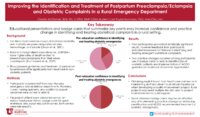 |
Improving the Identification and Treatment of Postpartum Preeclampsia/Eclampsia and Obstetric Complaints in a Rural Emergency Department | McDaniel, Charity | 2023 | POSTER |
| 13 |
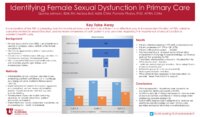 |
Identifying Female Sexual Dysfunction in Primary Care | Johnson, Quinta | 2023 | POSTER |
| 14 |
 |
Maturation 2.0: Menopause Group Education | Moxley, Alyssa | 2023 | Background: Up to 80 percent of perimenopausal women in the United States experience at least one vasomotor symptom of menopause, which persists for a median of 7.4 years (El Khoudary et al., 2019). Eighty-two percent report poor overall knowledge about the physiology of and treatment options during... |
| 15 |
 |
Screening for Postpartum Depression in the Newborn Intensive Care Unit (NICU) | Roberts, Emilia G. | 2023 | Background: Postpartum depression (PPD) is one of the most common obstetric complications that women will experience, with a prevalence of 12.5% in the United States. Women with infants admitted to the Newborn Intensive Care Unit (NICU) are at an even more significant risk for developing PPD, with a... |
| 16 |
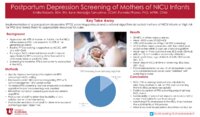 |
Screening for Postpartum Depression in the Newborn Intensive Care Unit (NICU) | Roberts, Emilia G. | 2023 | POSTER |
| 17 |
 |
Identifying Female Sexual Dysfunction in Primary Care | Johnson, Quinta | 2023 | Background: Female sexual dysfunction (FSD) commonly affects women across the lifespan though many components of FSD are easily treatable or improved with education. Many clinicians are ill-equipped to address FSD with patients in their daily practice due to a lack of training in their educational p... |
| 18 |
 |
Improving Provider Comfort in Discussing Race-Based Health Disparities in Pregnant and Birthing People | Creal, Cristi; Cohen, Susanna; Al-Khudairi, Amanda; Fall, Jeelan | 2022 | POSTER |
| 19 |
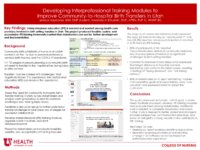 |
Developing Interprofessional Training Modules to Improve Community-to-Hospital Birth Transfers in Utah | Haymond, Jessica; Al-Khudairi, Amanda | 2022 | POSTER |
| 20 |
 |
Implementation of an Obstetric Triage Toolkit in a Rural Utah Hospital | Thompson, Elaine M.; Al-Khudairi, Amanda | 2022 | POSTER |
| 21 |
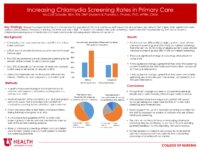 |
Increasing Chlamydia Screening Rates in Primary Care | Dowdle, McCall; Phares, Pamela | 2022 | POSTER |
| 22 |
 |
Improving Communication and Informed Consent Using a Birth Plan Decision Aid | Sartori, Brittney; Phares, Pamela | 2022 | Background: Birth plans are proven to have a positive impact on the birth experience and can be a useful tool for collaboration between patient and provider, but providers have historically seen little value in them. Sixty-six percent of providers do not recommend the use of birth plans to their pat... |
| 23 |
 |
Cervical Cancer Prevention: Improving Abnormal Pap Follow-Up | Fuqua, Dana M.; Taylor-Swanson, Lisa J. | 2022 | Background: Cervical cancer continues to be a pervasive disease despite effective screening (Pap test) and treatment options available to reduce morbidity and mortality of cancer progression. Studies suggest that nearly half of cervical cancer diagnoses result from a lack of follow-up after an abnor... |
| 24 |
 |
A Project to Implement Routine Perinatal Depression Screening at the St. George OB/GYN Clinic | Taylor, Buffy; Taylor-Swanson, Lisa | 2022 | Background: Perinatal depression (PD) is a complication of pregnancy and postpartum. Unfortunately, many obstetric and primary care providers do not screen for perinatal depression leading to its underdiagnosis. Untreated PD has severe consequences for the pregnancy dyad and family, ranging from pre... |
| 25 |
 |
Improving Nurse Confidence and Competence of Speculum Exams Through Enhanced Training and Available Resources in the Labor and Delivery Triage Setting | Evertsen, Sadie H.; Al-Khudairi, Amanda | 2022 | Background: Pelvic exams with a speculum are often necessary to evaluate patients and complete medical screening exams in the obstetric triage setting. Labor and Delivery nurses often lack confidence and competence when performing speculum exams due to the infrequent and limited training, the absenc... |
